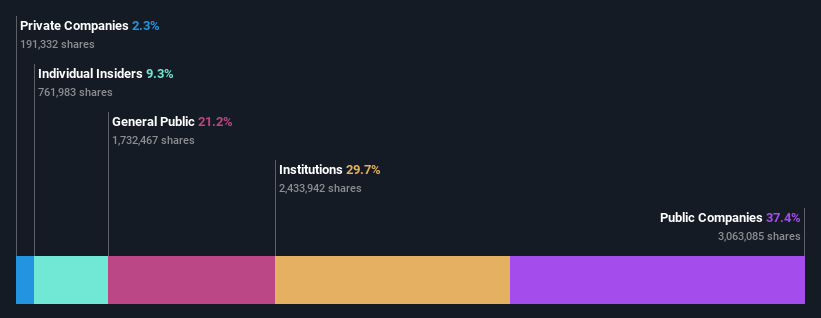- United States
- /
- Professional Services
- /
- NYSE:SKIL
Skillsoft Corp.'s (NYSE:SKIL) market cap touched US$119m last week, benefiting both public companies who own 37% as well as institutions

Key Insights
- Significant control over Skillsoft by public companies implies that the general public has more power to influence management and governance-related decisions
- 54% of the business is held by the top 4 shareholders
- Institutional ownership in Skillsoft is 30%
If you want to know who really controls Skillsoft Corp. (NYSE:SKIL), then you'll have to look at the makeup of its share registry. The group holding the most number of shares in the company, around 37% to be precise, is public companies. In other words, the group stands to gain the most (or lose the most) from their investment into the company.
While public companies were the group that reaped the most benefits after last week’s 26% price gain, institutions also received a 30% cut.
In the chart below, we zoom in on the different ownership groups of Skillsoft.
See our latest analysis for Skillsoft

What Does The Institutional Ownership Tell Us About Skillsoft?
Institutional investors commonly compare their own returns to the returns of a commonly followed index. So they generally do consider buying larger companies that are included in the relevant benchmark index.
As you can see, institutional investors have a fair amount of stake in Skillsoft. This suggests some credibility amongst professional investors. But we can't rely on that fact alone since institutions make bad investments sometimes, just like everyone does. It is not uncommon to see a big share price drop if two large institutional investors try to sell out of a stock at the same time. So it is worth checking the past earnings trajectory of Skillsoft, (below). Of course, keep in mind that there are other factors to consider, too.

Skillsoft is not owned by hedge funds. The company's largest shareholder is Naspers Limited, with ownership of 37%. With 8.1% and 4.2% of the shares outstanding respectively, Paradice Investment Management Pty Ltd. and Michael Klein are the second and third largest shareholders. Michael Klein, who is the third-largest shareholder, also happens to hold the title of Member of the Board of Directors.
To make our study more interesting, we found that the top 4 shareholders control more than half of the company which implies that this group has considerable sway over the company's decision-making.
While it makes sense to study institutional ownership data for a company, it also makes sense to study analyst sentiments to know which way the wind is blowing. There are plenty of analysts covering the stock, so it might be worth seeing what they are forecasting, too.
Insider Ownership Of Skillsoft
While the precise definition of an insider can be subjective, almost everyone considers board members to be insiders. Company management run the business, but the CEO will answer to the board, even if he or she is a member of it.
Insider ownership is positive when it signals leadership are thinking like the true owners of the company. However, high insider ownership can also give immense power to a small group within the company. This can be negative in some circumstances.
We can see that insiders own shares in Skillsoft Corp.. In their own names, insiders own US$11m worth of stock in the US$119m company. Some would say this shows alignment of interests between shareholders and the board, though we generally prefer to see bigger insider holdings. But it might be worth checking if those insiders have been selling.
General Public Ownership
With a 21% ownership, the general public, mostly comprising of individual investors, have some degree of sway over Skillsoft. While this group can't necessarily call the shots, it can certainly have a real influence on how the company is run.
Public Company Ownership
Public companies currently own 37% of Skillsoft stock. It's hard to say for sure but this suggests they have entwined business interests. This might be a strategic stake, so it's worth watching this space for changes in ownership.
Next Steps:
It's always worth thinking about the different groups who own shares in a company. But to understand Skillsoft better, we need to consider many other factors. To that end, you should learn about the 3 warning signs we've spotted with Skillsoft (including 1 which doesn't sit too well with us) .
If you are like me, you may want to think about whether this company will grow or shrink. Luckily, you can check this free report showing analyst forecasts for its future.
NB: Figures in this article are calculated using data from the last twelve months, which refer to the 12-month period ending on the last date of the month the financial statement is dated. This may not be consistent with full year annual report figures.
New: Manage All Your Stock Portfolios in One Place
We've created the ultimate portfolio companion for stock investors, and it's free.
• Connect an unlimited number of Portfolios and see your total in one currency
• Be alerted to new Warning Signs or Risks via email or mobile
• Track the Fair Value of your stocks
Have feedback on this article? Concerned about the content? Get in touch with us directly. Alternatively, email editorial-team (at) simplywallst.com.
This article by Simply Wall St is general in nature. We provide commentary based on historical data and analyst forecasts only using an unbiased methodology and our articles are not intended to be financial advice. It does not constitute a recommendation to buy or sell any stock, and does not take account of your objectives, or your financial situation. We aim to bring you long-term focused analysis driven by fundamental data. Note that our analysis may not factor in the latest price-sensitive company announcements or qualitative material. Simply Wall St has no position in any stocks mentioned.
About NYSE:SKIL
Skillsoft
Provides content and platform and instructor-led training services in the United States and internationally.
Fair value low.


